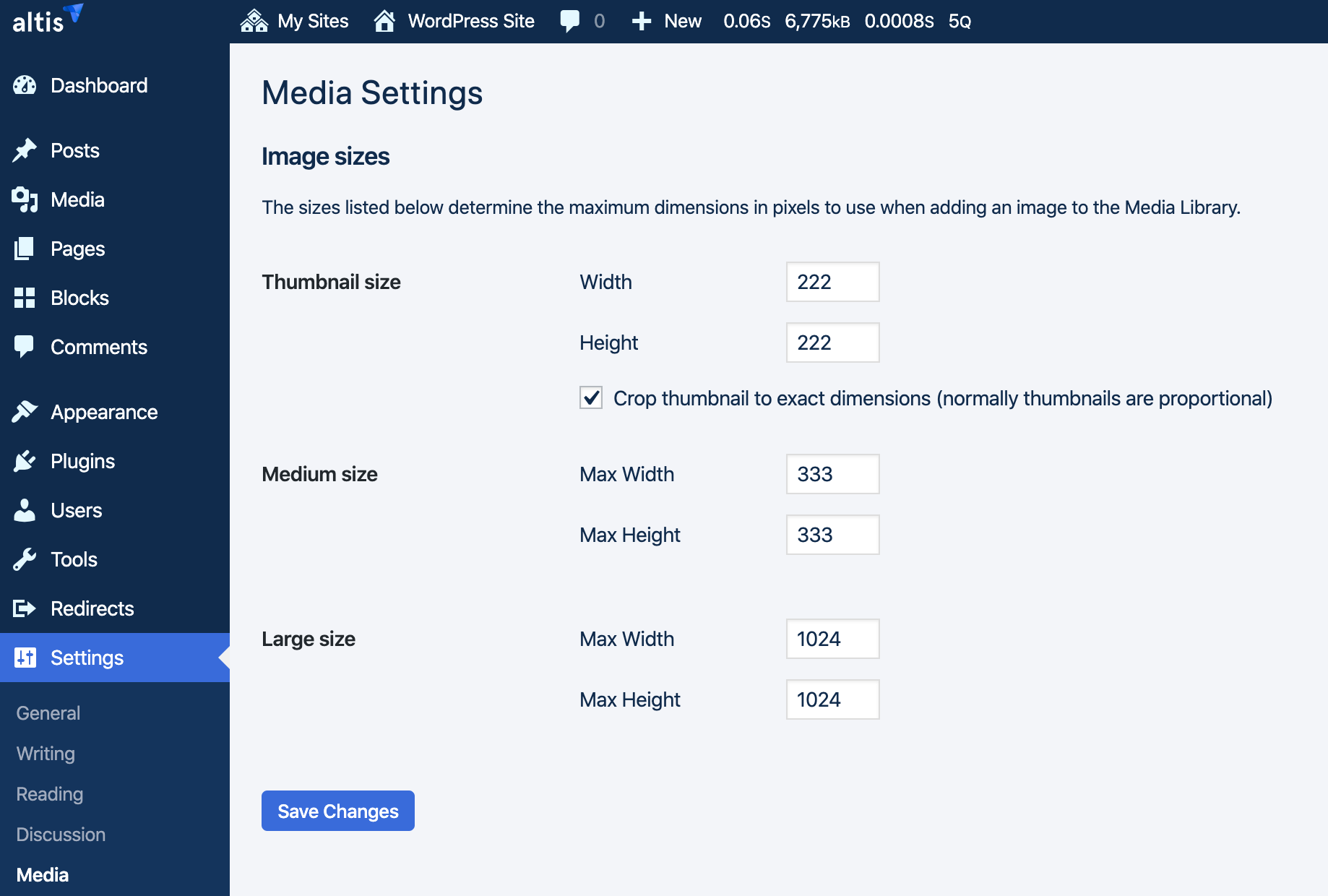Defining Image Sizes
Altis provides some default image sizes, that you can use to render images in the theme.
- Thumbnail
- Medium
- Large
- Post Thumbnail
- Full
They have default dimensions, but you can override these either with code or in the admin, under Settings > Media.

A lot of times, you'll find that you need custom image sizes for different contexts, depending on your theme's design.
You can define custom image sizes with the add_image_size() function.
This function accepts the following parameters:
string $name: Image size identifier.int $width: Optional. Image width in pixels. Default 0.int $height: Optional. Image height in pixels. Default 0.bool|array $crop: Optional. Whether to crop images to specified width and height or resize.
The custom image sizes should be declared in the callback function to the after_setup_theme action.
Example:
add_action( 'after_setup_theme', 'theme_setup' );
function theme_setup() {
// Set the image size by resizing the image while maintaining the aspect ratio:
add_image_size( 'constrained-thumbnail', 220, 180 ); // Image constrained to 220 pixels wide by 180 pixels tall
// Set the image size by cropping the image (not showing part of it):
add_image_size( 'cropped-thumbnail', 220, 180, true ); // Exactly 220 pixels wide by 180 pixels tall
// Set the image size by cropping the image and defining a crop position:
add_image_size( 'top-left-crop', 220, 220, [ 'left', 'top' ] ); // Hard crop left top
}
Custom images sizes do not show up in the editor by default when editing image blocks. See the Hooks and Filters section below to find out how to do this.
Cropping
Cropping behavior for the image size is dependent on the value of $crop:
- If
false(default), images will be scaled, not cropped. - If an array in the form of
[ x_crop_position, y_crop_position ]:x_crop_positionaccepts 'left' 'center', or 'right'.y_crop_positionaccepts 'top', 'center', or 'bottom'.
- If
true, images will be cropped to the specified dimensions using smart cropping by default, otherwise falling back to center cropping.
You can find more info in the WordPress developer guide
Using The Custom Sizes
Once you've defined custom image sizes there are different ways you can use them.
You can display a post's featured image at a given size:
// Output the post thumbnail image tag:
the_post_thumbnail( 'custom-size' );
You can also display any uploaded image by its attachment ID:
$src = wp_get_attachment_image_src( $attachment_id , 'custom-size' );
$img_url = $src[0];
echo ( ! empty( $img_url ) ) ? $img_url : '';
Hooks And Filters
image_size_names_choose
This filter allows you to make your custom image sizes available for selection in the admin.
Runs before rendering the list of available image sizes in the sidebar of the media edit screen. Used in conjuction with add_image_size()
add_filter( 'image_size_names_choose', function ( array $sizes ) : array {
$sizes['category-thumb'] = __( 'Category Thumb' );
return $sizes;
} );

You can find the full documentation for this filter here.
Dynamically Defined With A Size Array
In cases where a specific image size might only be used once you can define the image size via an array of width and height values in pixels:
$thumb_url = wp_get_attachment_image_src( $attachment_id, [ 900, 450 ], true );`
NOTE: This method of defining dimensions currently does not support cropping.
 Documentation
Documentation